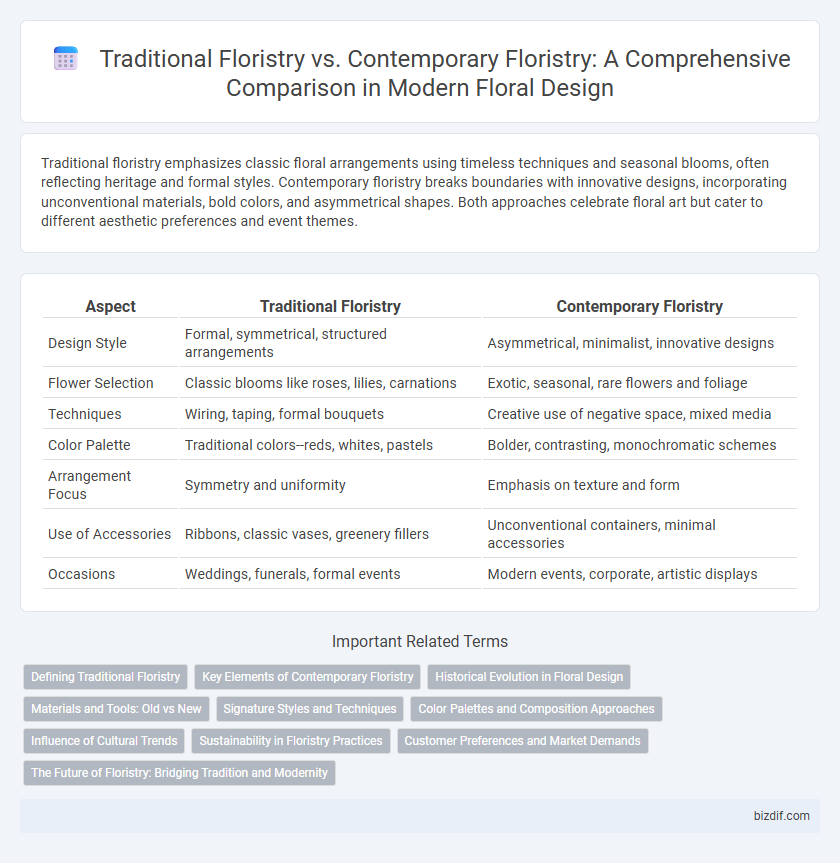Traditional floristry emphasizes classic floral arrangements using timeless techniques and seasonal blooms, often reflecting heritage and formal styles. Contemporary floristry breaks boundaries with innovative designs, incorporating unconventional materials, bold colors, and asymmetrical shapes. Both approaches celebrate floral art but cater to different aesthetic preferences and event themes.
Table of Comparison
| Aspect | Traditional Floristry | Contemporary Floristry |
|---|---|---|
| Design Style | Formal, symmetrical, structured arrangements | Asymmetrical, minimalist, innovative designs |
| Flower Selection | Classic blooms like roses, lilies, carnations | Exotic, seasonal, rare flowers and foliage |
| Techniques | Wiring, taping, formal bouquets | Creative use of negative space, mixed media |
| Color Palette | Traditional colors--reds, whites, pastels | Bolder, contrasting, monochromatic schemes |
| Arrangement Focus | Symmetry and uniformity | Emphasis on texture and form |
| Use of Accessories | Ribbons, classic vases, greenery fillers | Unconventional containers, minimal accessories |
| Occasions | Weddings, funerals, formal events | Modern events, corporate, artistic displays |
Defining Traditional Floristry
Traditional floristry emphasizes classic design principles, including symmetrical arrangements, formal structures, and the use of common flowers like roses, carnations, and lilies. This style often follows time-honored techniques such as hand-tied bouquets and formal centerpieces, showcasing balance, proportion, and harmonious color schemes. Rooted in historical customs, traditional floristry highlights elegance and timeless beauty through meticulous craftsmanship and predictable floral patterns.
Key Elements of Contemporary Floristry
Contemporary floristry emphasizes innovative design, incorporating unexpected materials and sculptural forms that challenge traditional symmetry and structure. Key elements include a focus on minimalism, use of vibrant colors, and asymmetrical compositions that highlight texture and negative space. This approach showcases creativity through blending natural and artificial components, resulting in dynamic, visually striking floral arrangements.
Historical Evolution in Floral Design
Traditional floristry, rooted in centuries-old techniques, emphasizes symmetrical arrangements, classical shapes, and the use of local, seasonal flowers reflecting cultural customs. Contemporary floristry has evolved to incorporate innovative materials, asymmetrical designs, and global floral varieties driven by modern aesthetics and sustainability trends. The historical evolution in floral design highlights a shift from rigid, formal styles toward creative, expressive compositions influenced by changing artistic movements and environmental awareness.
Materials and Tools: Old vs New
Traditional floristry primarily relies on natural materials such as fresh flowers, foliage, and organic binding agents like floral foam and wire, emphasizing hand-tied techniques. Contemporary floristry incorporates innovative materials including synthetic stems, preserved flowers, and eco-friendly alternatives to floral foam, paired with advanced tools like floral glue guns and computerized design software. The evolution in materials and tools reflects a shift toward sustainability and creative flexibility in modern floral design.
Signature Styles and Techniques
Traditional floristry emphasizes structured arrangements using classic techniques such as symmetrical balance, tight spirals, and formal shapes like bouquets and wreaths, highlighting timeless floral designs with roses, lilies, and carnations. Contemporary floristry embraces innovative styles, incorporating asymmetry, mixed textures, and unusual materials like succulents and preserved flowers, focusing on artistic expression and personalization. Signature techniques in contemporary floristry include hand-tied bouquets with loose, organic forms and the use of eco-friendly floral foam alternatives, contrasting the precision and formality of traditional methods.
Color Palettes and Composition Approaches
Traditional floristry emphasizes classic color palettes with harmonious, muted tones such as pastels and soft whites, often arranged in symmetrical, balanced compositions that follow established design rules. Contemporary floristry embraces bold, vibrant colors and unexpected combinations, using asymmetrical, free-form arrangements that highlight texture, contrast, and artistic expression. These differing approaches reflect a shift from rigid structure to creative innovation in floral design.
Influence of Cultural Trends
Traditional floristry emphasizes classic floral arrangements rooted in cultural heritage, showcasing symmetrical designs and indigenous flowers that reflect long-standing customs. Contemporary floristry incorporates global cultural trends and modern aesthetics, using unconventional materials and asymmetrical forms to express individuality and innovation. The influence of cultural trends drives the evolution from rigid traditional styles to dynamic, diverse expressions in floral art.
Sustainability in Floristry Practices
Traditional floristry often relies on imported flowers and synthetic materials, leading to higher carbon footprints and waste. Contemporary floristry emphasizes sustainable practices through locally sourced blooms, seasonal arrangements, and biodegradable supplies, reducing environmental impact. Eco-conscious florists are increasingly adopting these methods to promote sustainability in the floral industry.
Customer Preferences and Market Demands
Traditional floristry emphasizes classic arrangements with structured designs and a focus on symmetry, appealing to customers who value timeless elegance and conventional aesthetics. Contemporary floristry responds to market demands by incorporating unconventional materials, asymmetrical shapes, and innovative color palettes, attracting clients seeking modern, personalized floral expressions. Shifts in customer preferences toward sustainability and unique experiences drive florists to blend both traditional techniques and contemporary creativity in their offerings.
The Future of Floristry: Bridging Tradition and Modernity
Traditional floristry emphasizes classic arrangements, symmetry, and heritage techniques passed down through generations, while contemporary floristry embraces innovation, unique textures, and bold color palettes to reflect modern aesthetics. The future of floristry lies in blending these approaches, integrating sustainable practices, digital design tools, and personalized customer experiences to create eco-conscious and visually striking floral art. Florists who master both tradition and innovation are poised to redefine industry standards and meet evolving consumer demands.
Traditional Floristry vs Contemporary Floristry Infographic

 bizdif.com
bizdif.com